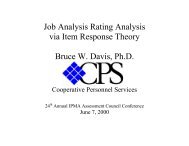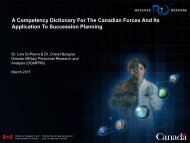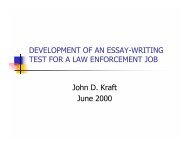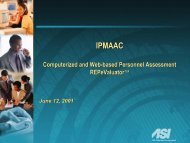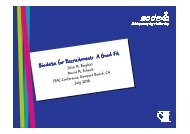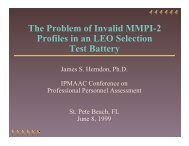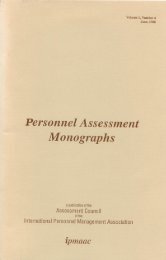New Methods for Reducing Adverse Impact and Preserving ... - IPAC
New Methods for Reducing Adverse Impact and Preserving ... - IPAC
New Methods for Reducing Adverse Impact and Preserving ... - IPAC
You also want an ePaper? Increase the reach of your titles
YUMPU automatically turns print PDFs into web optimized ePapers that Google loves.
<strong>New</strong> <strong>Methods</strong> <strong>for</strong> <strong>Reducing</strong><br />
<strong>Adverse</strong> <strong>Impact</strong> <strong>and</strong> <strong>Preserving</strong><br />
Validity<br />
Joel P. Wiesen, Ph.D.<br />
Herman Aguinis, Ph.D.<br />
Tuvshingus Batdelger, Ph.D.<br />
jwiesen@appliedpersonnelresearch.com<br />
<strong>IPAC</strong> 2010 Conference<br />
<strong>New</strong>port Beach, CA<br />
July 19, 2010<br />
Wiesen, Aguinis & Batdelger (2010)<br />
2010 <strong>IPAC</strong> Annual Conference<br />
1
Acknowledgements/Thanks<br />
• Program committee<br />
• Coauthors<br />
• Support staff<br />
– Aaron Brown<br />
Wiesen, Aguinis & Batdelger (2010)<br />
2010 <strong>IPAC</strong> Annual Conference<br />
2
Overview<br />
• Developed completely new selection<br />
methods based on existing tests<br />
• Compared new with traditional selection<br />
methods in a large Monte Carlo study<br />
Wiesen, Aguinis & Batdelger (2010)<br />
2010 <strong>IPAC</strong> Annual Conference<br />
3
Test Battery Studied<br />
• General Mental Ability (GMA, m/c test)<br />
• Conscientiousness (CONSC)<br />
• Physical Per<strong>for</strong>mance Test (PPT)<br />
• Structured Interview (SI)<br />
Wiesen, Aguinis & Batdelger (2010)<br />
2010 <strong>IPAC</strong> Annual Conference<br />
4
What is <strong>New</strong><br />
• Tests are typical<br />
• Novelty involves ways to use the test data<br />
• Not all tests contribute to the grade of each<br />
applicant<br />
• Choose tests based on the strengths or<br />
weaknesses of the applicant<br />
Wiesen, Aguinis & Batdelger (2010)<br />
2010 <strong>IPAC</strong> Annual Conference<br />
5
<strong>New</strong> Selection <strong>Methods</strong><br />
• Greatest Strength Method (GSM)<br />
• Two Greatest Strengths Method (GSM2)<br />
• Drop the Lowest Score (DROP)<br />
• Composite without GMA (COMP2)<br />
Wiesen, Aguinis & Batdelger (2010)<br />
2010 <strong>IPAC</strong> Annual Conference<br />
6
Comparison <strong>Methods</strong><br />
• GMA alone<br />
• Composite of all tests (COMP)<br />
• R<strong>and</strong>om (RAND)<br />
Wiesen, Aguinis & Batdelger (2010)<br />
2010 <strong>IPAC</strong> Annual Conference<br />
7
Evaluation Areas<br />
• Validity<br />
• <strong>Adverse</strong> <strong>Impact</strong> (AI)<br />
• St<strong>and</strong>ardized Mean Group Difference (d)<br />
• Mean Job Per<strong>for</strong>mance (MJP)<br />
Wiesen, Aguinis & Batdelger (2010)<br />
2010 <strong>IPAC</strong> Annual Conference<br />
8
Quick Look at Findings<br />
• Preserve much validity<br />
• Reduce AI<br />
• Some caveats<br />
Wiesen, Aguinis & Batdelger (2010)<br />
2010 <strong>IPAC</strong> Annual Conference<br />
9
<strong>New</strong> <strong>Methods</strong> Explained<br />
• Determine z-score <strong>for</strong> each test<br />
• Calculate method grades based on z-scores<br />
Wiesen, Aguinis & Batdelger (2010)<br />
2010 <strong>IPAC</strong> Annual Conference<br />
10
Greatest Strength Method<br />
(GSM)<br />
• Determine test with greatest z-score<br />
• Grade = that z-score<br />
• Fail any c<strong>and</strong>idate with a low score on any<br />
test<br />
• Rank c<strong>and</strong>idates based on grade<br />
Wiesen, Aguinis & Batdelger (2010)<br />
2010 <strong>IPAC</strong> Annual Conference<br />
11
Two Greatest Strengths Method<br />
(GSM2)<br />
• Determine the 2 tests with greatest z-scores<br />
• Grade = composite of those 2 z-scores<br />
• Fail any c<strong>and</strong>idate with a low score on any<br />
test<br />
• Rank c<strong>and</strong>idates based on grade<br />
Wiesen, Aguinis & Batdelger (2010)<br />
2010 <strong>IPAC</strong> Annual Conference<br />
12
Drop the Lowest Score Method<br />
(DROP)<br />
• Determine test with lowest z-score<br />
• Grade = composite of remaining 3 z-scores<br />
• Fail any c<strong>and</strong>idate with a low score on any<br />
test<br />
• Rank c<strong>and</strong>idates based on grade<br />
Wiesen, Aguinis & Batdelger (2010)<br />
2010 <strong>IPAC</strong> Annual Conference<br />
13
Compensatory Omitting GMA<br />
(COMP2)<br />
• Omit GMA (i.e., m/c test)<br />
• Grade = composite of other 3 z-scores<br />
• Rank c<strong>and</strong>idates based on grade<br />
Wiesen, Aguinis & Batdelger (2010)<br />
2010 <strong>IPAC</strong> Annual Conference<br />
14
Comparison <strong>Methods</strong> Explained<br />
• Determine z-score grade <strong>for</strong> each test<br />
• Calculate method scores based on grades<br />
Wiesen, Aguinis & Batdelger (2010)<br />
2010 <strong>IPAC</strong> Annual Conference<br />
15
GMA Test Alone<br />
• Grade = z-score <strong>for</strong> GMA (i.e., m/c test)<br />
• Rank c<strong>and</strong>idates based on grade<br />
Wiesen, Aguinis & Batdelger (2010)<br />
2010 <strong>IPAC</strong> Annual Conference<br />
16
COMP<br />
• Grade = composite of all 4 z-scores<br />
• Rank c<strong>and</strong>idates based on grade<br />
Wiesen, Aguinis & Batdelger (2010)<br />
2010 <strong>IPAC</strong> Annual Conference<br />
17
RAND<br />
• Grade ignores all test -scores<br />
• Rank c<strong>and</strong>idates r<strong>and</strong>omly<br />
Wiesen, Aguinis & Batdelger (2010)<br />
2010 <strong>IPAC</strong> Annual Conference<br />
18
Simulation Study Methodology<br />
• Specify intercorrelations<br />
• Generate data with these intercorrelations<br />
• Create gender <strong>and</strong> EEO groups<br />
• Create mean score differences<br />
• Compute grades using 7 different methods<br />
• Make selections under the various methods<br />
• Evaluate validity, AI, etc.<br />
Wiesen, Aguinis & Batdelger (2010)<br />
2010 <strong>IPAC</strong> Annual Conference<br />
19
Intercorrelation Inputs<br />
SI<br />
PPT<br />
CONSC<br />
Job Per<strong>for</strong>mance<br />
GMA .31<br />
0<br />
.03<br />
.51<br />
SI<br />
0<br />
0<br />
.48<br />
PPT<br />
0<br />
.35<br />
CONSC<br />
.22<br />
Wiesen, Aguinis & Batdelger (2010)<br />
2010 <strong>IPAC</strong> Annual Conference<br />
20
Create Mean Score Differences<br />
GMA<br />
ORAL<br />
PPT<br />
CONSC<br />
Job<br />
Perf.<br />
Women<br />
(Case 1)<br />
0<br />
0<br />
-1.25<br />
0<br />
0<br />
Women<br />
(Case 2)<br />
0<br />
0<br />
-1.25<br />
0<br />
-.4375<br />
Ethnic<br />
Group<br />
-.72<br />
-.31<br />
0<br />
.07<br />
-.27<br />
Wiesen, Aguinis & Batdelger (2010)<br />
2010 <strong>IPAC</strong> Annual Conference<br />
21
Some Variables Considered<br />
• Selection ratio (SR)<br />
– Lower SRs typically yield worse AI<br />
• Proportion of ethnic minority applicants<br />
(EEO)<br />
• Applicant group size<br />
Wiesen, Aguinis & Batdelger (2010)<br />
2010 <strong>IPAC</strong> Annual Conference<br />
22
Selection Ratio (SR)<br />
• .01<br />
• .05<br />
• .15<br />
• .20<br />
• .30<br />
• .50<br />
• .90<br />
Wiesen, Aguinis & Batdelger (2010)<br />
2010 <strong>IPAC</strong> Annual Conference<br />
23
• .05<br />
• .10<br />
• .20<br />
• .30<br />
• .40<br />
• .50<br />
Proportion of Ethnic Minority<br />
Applicants (EEO)<br />
Wiesen, Aguinis & Batdelger (2010)<br />
2010 <strong>IPAC</strong> Annual Conference<br />
24
Applicant Group Size<br />
• 500<br />
• 1,000<br />
• 2,000<br />
• 10,000<br />
• 750,000<br />
Wiesen, Aguinis & Batdelger (2010)<br />
2010 <strong>IPAC</strong> Annual Conference<br />
25
Number of Replications<br />
• Replicate until consider 750,000 cases<br />
– 1,500 replications <strong>for</strong> N of 500<br />
– 750 replications <strong>for</strong> N of 1,000<br />
– 375 replications <strong>for</strong> N of 2,000<br />
– 75 replications <strong>for</strong> N of 10,000<br />
– 1 replication <strong>for</strong> N of 750,000<br />
Wiesen, Aguinis & Batdelger (2010)<br />
2010 <strong>IPAC</strong> Annual Conference<br />
26
Design Summary<br />
• 7 levels of SR<br />
• 6 levels of EEO<br />
• 7 methods of using data<br />
• 2 genders<br />
– Case 1: No gender difference in MJP<br />
– Case 2: Gender difference in MJP<br />
• 2 EEO groups<br />
• 5 levels of sample size<br />
Wiesen, Aguinis & Batdelger (2010)<br />
2010 <strong>IPAC</strong> Annual Conference<br />
27
Results<br />
• Results varied somewhat by level<br />
• Will show results first <strong>for</strong><br />
– Total sample of 750,000<br />
– SR = .2<br />
– EEO = .2<br />
Wiesen, Aguinis & Batdelger (2010)<br />
2010 <strong>IPAC</strong> Annual Conference<br />
28
Validity<br />
Method<br />
Validity<br />
AI<br />
EEO<br />
AI<br />
Gender<br />
MJP<br />
Case 1<br />
MJP<br />
Case 2<br />
GMA<br />
0.51<br />
GSM<br />
0.52<br />
GSM2<br />
0.62<br />
DROP<br />
0.61<br />
COMP2<br />
0.57<br />
COMP<br />
0.69<br />
RAND<br />
0.00<br />
Wiesen, Aguinis & Batdelger (2010)<br />
2010 <strong>IPAC</strong> Annual Conference<br />
29
<strong>Adverse</strong> <strong>Impact</strong> (AI)<br />
Method<br />
Validity<br />
AI<br />
EEO<br />
AI<br />
Gender<br />
MJP<br />
Case 1<br />
MJP<br />
Case 2<br />
GMA<br />
0.51<br />
0.31<br />
1.00<br />
GSM<br />
0.52<br />
0.63<br />
0.66<br />
GSM2<br />
0.62<br />
0.56<br />
0.61<br />
DROP<br />
0.61<br />
0.53<br />
0.55<br />
COMP2<br />
0.57<br />
0.83<br />
0.35<br />
COMP<br />
0.69<br />
0.53<br />
0.44<br />
RAND<br />
0.00<br />
1.00<br />
1.00<br />
Wiesen, Aguinis & Batdelger (2010)<br />
2010 <strong>IPAC</strong> Annual Conference<br />
30
Mean Job Per<strong>for</strong>mance (MJP)<br />
Method<br />
Validity<br />
AI<br />
EEO<br />
AI<br />
Gender<br />
MJP<br />
Case 1<br />
MJP<br />
Case 2<br />
GMA<br />
0.51<br />
0.31<br />
1.00<br />
0.67<br />
0.45<br />
GSM<br />
0.52<br />
0.63<br />
0.66<br />
0.74<br />
0.57<br />
GSM2<br />
0.62<br />
0.56<br />
0.61<br />
0.85<br />
0.68<br />
DROP<br />
0.61<br />
0.53<br />
0.55<br />
0.90<br />
0.74<br />
COMP2<br />
0.57<br />
0.83<br />
0.35<br />
0.75<br />
0.63<br />
COMP<br />
0.69<br />
0.53<br />
0.44<br />
0.93<br />
0.79<br />
RAND<br />
0.00<br />
1.00<br />
1.00<br />
-0.06<br />
-0.27<br />
Wiesen, Aguinis & Batdelger (2010)<br />
2010 <strong>IPAC</strong> Annual Conference<br />
31
AI <strong>for</strong> EEO, by Method <strong>and</strong> SR<br />
(EEO50, N750,000)<br />
1.2<br />
1<br />
<strong>Adverse</strong> <strong>Impact</strong><br />
0.8<br />
0.6<br />
0.4<br />
0.2<br />
0<br />
0 0.1 0.2 0.3 0.4 0.5 0.6 0.7 0.8 0.9 1<br />
SR<br />
GSM GMA COMP COMP2 GSM2 DROP RANDOM<br />
Wiesen, Aguinis & Batdelger (2010)<br />
2010 <strong>IPAC</strong> Annual Conference<br />
32
AI <strong>for</strong> Gender, by Method <strong>and</strong> SR<br />
(EEO50, N750,000)<br />
1.2<br />
1<br />
<strong>Adverse</strong> <strong>Impact</strong><br />
0.8<br />
0.6<br />
0.4<br />
0.2<br />
0<br />
SR<br />
0 0.1 0.2 0.3 0.4 0.5 0.6 0.7 0.8 0.9 1<br />
Wiesen, Aguinis & Batdelger (2010)<br />
2010 <strong>IPAC</strong> Annual Conference<br />
33
Summary of Validity Results<br />
• Validity highest <strong>for</strong> COMP<br />
• Validity <strong>for</strong> novel methods also high<br />
• Validity <strong>for</strong> novel methods greater than<br />
GMA m/c test alone<br />
Wiesen, Aguinis & Batdelger (2010)<br />
2010 <strong>IPAC</strong> Annual Conference<br />
34
Summary of AI Results<br />
• Traditional approaches have relatively<br />
severe AI <strong>for</strong> EEO or gender or both<br />
– GMA has AI <strong>for</strong> EEO<br />
– COMP has AI <strong>for</strong> EEO <strong>and</strong> gender<br />
• Novel approaches reduce AI <strong>for</strong> BOTH<br />
EEO <strong>and</strong> gender<br />
– Especially GSM<br />
Wiesen, Aguinis & Batdelger (2010)<br />
2010 <strong>IPAC</strong> Annual Conference<br />
35
Caveats<br />
• High variability in AI<br />
– Often AI = zero, especially with<br />
• Small N<br />
• Low SR<br />
• Low EEO<br />
• Mathematical model approach<br />
Wiesen, Aguinis & Batdelger (2010)<br />
2010 <strong>IPAC</strong> Annual Conference<br />
36
Conclusions<br />
• Novel, simple ways to use test scores<br />
- GSM, GSM2 <strong>and</strong> DROP have promise<br />
- Will result in occupational diversity in<br />
terms of skills<br />
• Reduce adverse impact<br />
• Maintain much validity<br />
• One approach, not “the solution”<br />
Wiesen, Aguinis & Batdelger (2010)<br />
2010 <strong>IPAC</strong> Annual Conference<br />
37
Note on Occupational Diversity<br />
• More diverse mix of strengths/weaknesses<br />
in employees<br />
• Each employee may contribute based on<br />
strengths<br />
• May facilitate teamwork<br />
Wiesen, Aguinis & Batdelger (2010)<br />
2010 <strong>IPAC</strong> Annual Conference<br />
38
Final Thoughts<br />
• This is a simplified summary of the results of<br />
a large Monte Carlo study. Full paper is in<br />
preparation.<br />
• Call <strong>for</strong> collaboration in real life applications<br />
A more complete summary of this research will be available at:<br />
http://appliedpersonnelresearch.com/pubs.html<br />
Wiesen, Aguinis & Batdelger (2010)<br />
2010 <strong>IPAC</strong> Annual Conference<br />
39



